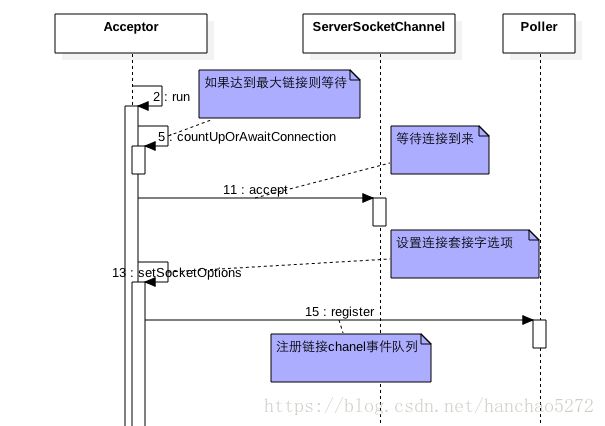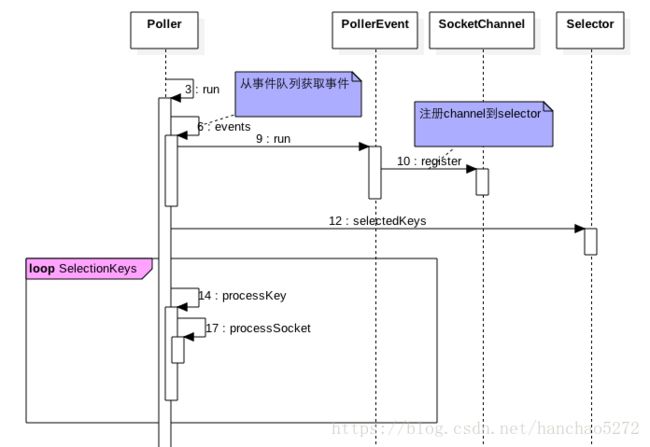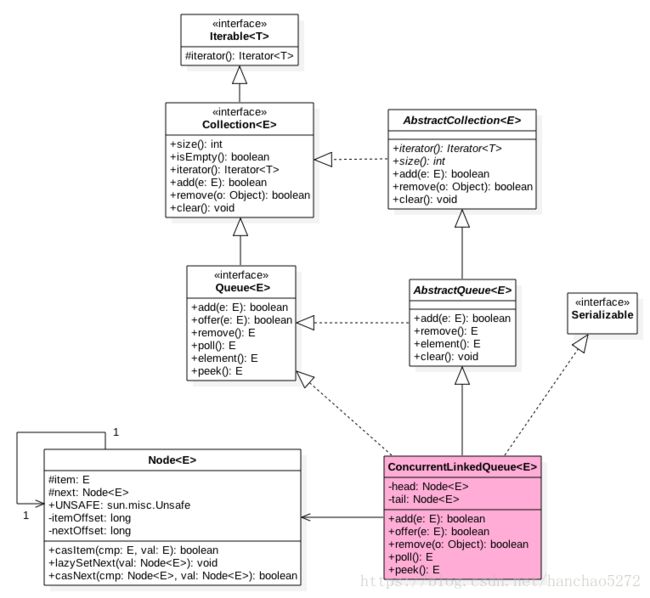Java并发47:并发集合系列-基于CAS算法的非阻塞单向无界队列ConcurrentLinkedQueue
[超级链接:Java并发学习系列-绪论]
[系列序章:Java并发43:并发集合系列-序章]
原文地址:https://www.jianshu.com/p/9e73b9216322
一、 前言
常用的并发队列有阻塞队列和非阻塞队列。
前者使用锁实现,后者则使用CAS非阻塞算法实现,使用非阻塞队列一般性能比较好。
下面就看看常用的非阻塞ConcurrentLinkedQueue是如何使用CAS实现的。
二、 ConcurrentLinkedQueue类图结构
如图ConcurrentLinkedQueue中有两个volatile类型的Node节点分别用来存在列表的首尾节点。
其中head节点存放链表第一个item为null的节点,tail则并不是总指向最后一个节点。
Node节点内部则维护一个变量item用来存放节点的值,next用来存放下一个节点,从而链接为一个单向无界列表。
public ConcurrentLinkedQueue() {
head = tail = new Node(null);
} 如上代码初始化时候会构建一个item为NULL的空节点作为链表的首尾节点。
三、offer操作
offer操作是在链表末尾添加一个元素,下面看看实现原理。
public boolean offer(E e) {
//e为null则抛出空指针异常
checkNotNull(e);
//构造Node节点构造函数内部调用unsafe.putObject,后面统一讲
final Node newNode = new Node(e);
//从尾节点插入
for (Node t = tail, p = t;;) {
Node q = p.next;
//如果q=null说明p是尾节点则插入
if (q == null) {
//cas插入(1)
if (p.casNext(null, newNode)) {
//cas成功说明新增节点已经被放入链表,然后设置当前尾节点(包含head,1,3,5.。。个节点为尾节点)
if (p != t) // hop two nodes at a time
casTail(t, newNode); // Failure is OK.
return true;
}
// Lost CAS race to another thread; re-read next
}
else if (p == q)//(2)
//多线程操作时候,由于poll时候会把老的head变为自引用,然后head的next变为新head,所以这里需要
//重新找新的head,因为新的head后面的节点才是激活的节点
p = (t != (t = tail)) ? t : head;
else
// 寻找尾节点(3)
p = (p != t && t != (t = tail)) ? t : q;
}
}
四、 add操作
add操作是在链表末尾添加一个元素,其实内部调用的还是offer,下面看看实现原理:
public boolean add(E e) {
return offer(e);
}poll操作
poll操作是在链表头部获取并且移除一个元素,下面看看实现原理。
public E poll() {
restartFromHead:
//死循环
for (;;) {
//死循环
for (Node h = head, p = h, q;;) {
//保存当前节点值
E item = p.item;
//当前节点有值则cas变为null(1)
if (item != null && p.casItem(item, null)) {
//cas成功标志当前节点以及从链表中移除
if (p != h) // 类似tail间隔2设置一次头节点(2)
updateHead(h, ((q = p.next) != null) ? q : p);
return item;
}
//当前队列为空则返回null(3)
else if ((q = p.next) == null) {
updateHead(h, p);
return null;
}
//自引用了,则重新找新的队列头节点(4)
else if (p == q)
continue restartFromHead;
else//(5)
p = q;
}
}
}
final void updateHead(Node h, Node p) {
if (h != p && casHead(h, p))
h.lazySetNext(h);
}
六、peek操作
peek操作是获取链表头部一个元素(只读取不移除),下面看看实现原理。
代码与poll类似,只是少了castItem。
并且peek操作会改变head指向,offer后head指向哨兵节点,第一次peek后head会指向第一个真的节点元素。
public E peek() {
restartFromHead:
for (;;) {
for (Node h = head, p = h, q;;) {
E item = p.item;
if (item != null || (q = p.next) == null) {
updateHead(h, p);
return item;
}
else if (p == q)
continue restartFromHead;
else
p = q;
}
}
}
七、size操作
size获取当前队列元素个数,在并发环境下不是很有用。
因为使用CAS没有加锁所以从调用size函数到返回结果期间有可能增删元素,导致统计的元素个数不精确。
public int size() {
int count = 0;
for (Node p = first(); p != null; p = succ(p))
if (p.item != null)
// 最大返回Integer.MAX_VALUE
if (++count == Integer.MAX_VALUE)
break;
return count;
}
//获取第一个队列元素(哨兵元素不算),没有则为null
Node first() {
restartFromHead:
for (;;) {
for (Node h = head, p = h, q;;) {
boolean hasItem = (p.item != null);
if (hasItem || (q = p.next) == null) {
updateHead(h, p);
return hasItem ? p : null;
}
else if (p == q)
continue restartFromHead;
else
p = q;
}
}
}
//获取当前节点的next元素,如果是自引入节点则返回真正头节点
final Node succ(Node p) {
Node next = p.next;
return (p == next) ? head : next;
}
八、remove操作
如果队列里面存在该元素则删除给元素,如果存在多个则删除第一个,并返回true,否者返回false。
public boolean remove(Object o) {
//查找元素为空,直接返回false
if (o == null) return false;
Node pred = null;
for (Node p = first(); p != null; p = succ(p)) {
E item = p.item;
//相等则使用cas值null,同时一个线程成功,失败的线程循环查找队列中其他元素是否有匹配的。
if (item != null &&
o.equals(item) &&
p.casItem(item, null)) {
//获取next元素
Node next = succ(p);
//如果有前驱节点,并且next不为空则链接前驱节点到next,
if (pred != null && next != null)
pred.casNext(p, next);
return true;
}
pred = p;
}
return false;
}
九、contains操作
判断队列里面是否含有指定对象,由于是遍历整个队列,所以类似size 不是那么精确。
有可能调用该方法时候元素还在队列里面,但是遍历过程中才把该元素删除了,那么就会返回false.
public boolean contains(Object o) {
if (o == null) return false;
for (Node p = first(); p != null; p = succ(p)) {
E item = p.item;
if (item != null && o.equals(item))
return true;
}
return false;
}
十、开源框架中使用
Tomcat中NioEndPoint中的每个poller里面就维护一个ConcurrentLinkedQueue用来作为缓冲存放任务。
10.1 Acceptor线程
accept线程作用是接受客户端发来的连接请求并放入到事件队列。

看下代码:
protected class Acceptor extends AbstractEndpoint.Acceptor {
@Override
public void run() {
int errorDelay = 0;
// 一直循环直到接收到shutdown命令
while (running) {
...
if (!running) {
break;
}
state = AcceptorState.RUNNING;
try {
//如果达到max connections个请求则等待
countUpOrAwaitConnection();
SocketChannel socket = null;
try {
// 从TCP缓存获取一个完成三次握手的套接字,没有则阻塞
// socket
socket = serverSock.accept();
} catch (IOException ioe) {
...
}
// Successful accept, reset the error delay
errorDelay = 0;
if (running && !paused) {
if (!setSocketOptions(socket)) {
countDownConnection();
closeSocket(socket);
}
} else {
countDownConnection();
closeSocket(socket);
}
....
} catch (SocketTimeoutException sx) {
// Ignore: Normal condition
....
}
state = AcceptorState.ENDED;
}
}
protected boolean setSocketOptions(SocketChannel socket) {
// Process the connection
try {
//disable blocking, APR style, we are gonna be polling it
...
getPoller0().register(channel);
} catch (Throwable t) {
...
return false;
}
return true;
}
public void register(final NioChannel socket) {
...
addEvent(r);
}
public void addEvent(Runnable event) {
events.offer(event);
...
}
10.2 Poll线程
poll线程作用是从事件队列里面获取事件把链接套接字加入selector,并且监听socket事件进行处理。

看下代码:
public void run() {
while (true) {
try {
...
if (close) {
...
} else {
hasEvents = events();
}
try {
...
} catch ( NullPointerException x ) {...
}
Iterator iterator =
keyCount > 0 ? selector.selectedKeys().iterator() : null;
// 遍历所有注册的channel对感兴趣的事件处理
while (iterator != null && iterator.hasNext()) {
SelectionKey sk = iterator.next();
KeyAttachment attachment = (KeyAttachment)sk.attachment();
if (attachment == null) {
iterator.remove();
} else {
attachment.access();
iterator.remove();
processKey(sk, attachment);
}
}//while
//process timeouts
timeout(keyCount,hasEvents);
if ( oomParachute > 0 && oomParachuteData == null ) checkParachute();
} catch (OutOfMemoryError oom) {
...
}
}//while
synchronized (this) {
this.notifyAll();
}
stopLatch.countDown();
} public boolean events() {
boolean result = false;
//从队列获取任务并执行
Runnable r = null;
while ( (r = events.poll()) != null ) {
result = true;
try {
r.run();
if ( r instanceof PollerEvent ) {
((PollerEvent)r).reset();
eventCache.offer((PollerEvent)r);
}
} catch ( Throwable x ) {
log.error("",x);
}
}
return result;
}
//如配置线程池则请求交给线程池处理。
public boolean processSocket(NioChannel socket, SocketStatus status, boolean dispatch) {
try {
KeyAttachment attachment = (KeyAttachment)socket.getAttachment();
if (attachment == null) {
return false;
}
attachment.setCometNotify(false); //will get reset upon next reg
SocketProcessor sc = processorCache.poll();
if ( sc == null ) sc = new SocketProcessor(socket,status);
else sc.reset(socket,status);
if ( dispatch && getExecutor()!=null ) getExecutor().execute(sc);
else sc.run();
} catch (RejectedExecutionException rx) {
...
}
return true;
}
十一、有意思的问题
10.1 一个判断的执行结果分析
offer中有个 判断 t != (t = tail)。
假如 t=node1;tail=node2;并且node1!=node2那么这个判断是true还是false?答案是true。
这个判断是看当前t是不是和tail相等,相等则返回false否者为true,但是无论结果是啥执行后t的值都是tail。
下面从字节码来分析下为啥?
一个例子
public static void main(String[] args) {
int t = 2;
int tail = 3;
System.out.println(t != (t = tail));
}结果为:true
10.2 Node的构造函数
另外对于每个节点Node在构造时候使用UnSafe.putObject设置item替代了直接对volatile的赋值,这个是为了性能考虑?
为啥不直接赋值那,看看类注解怎么说:
Node(E item) {
UNSAFE.putObject(this, itemOffset, item);
}When constructing a Node (before enqueuing it) we avoid paying for a volatile write to item by using Unsafe.putObject instead of a normal write. This allows the cost of enqueue to be”one-and-a-half”
CASes.
也就是说当构造Node节点时候(这时候节点还没有放入队列链表)为了避免正常的写volatile变量的开销 使用了Unsafe.putObject代替。
这使元素进队列仅仅花费1.5个cas操作的耗时。
这个是说使用Unsafe.putObject比直接给volatile变量赋值更高效?目前还没有查到相关资料。
十二、总结
ConcurrentLinkedQueue使用CAS非阻塞算法实现使用CAS解决了当前节点与next节点之间的安全链接和对当前节点值的赋值。
由于使用CAS没有使用锁,所以size和contains的时候有可能进行offer,poll或者remove操作,导致获取的元素个数不精确,所以在并发情况下size和contains函数不是很有用。
另外第一次peek或者first时候会把head指向第一个真正的队列元素。
下面总结下如何实现线程安全的,可知入队出队函数都是操作volatile变量:head,tail。
所以要保证队列线程安全只需要保证对这两个Node操作的可见性和原子性,由于volatile本身保证可见性,所以只需要看下多线程下如果保证对着两个变量操作的原子性。
对于offer操作是在tail后面添加元素,也就是调用tail.casNext方法,而这个方法是使用的CAS操作,只有一个线程会成功,然后失败的线程会循环一下,重新获取tail,然后执行casNext方法。对于poll也是这样的。
